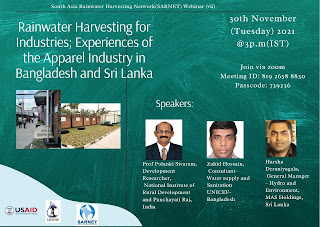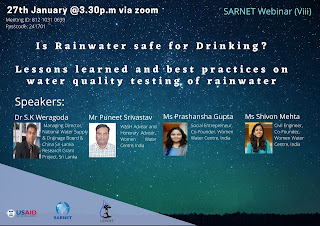Experiences of the Apparel industry in Bangladesh and Sri Lanka demonstrate that rainwater harvesting can contribute to reducing the water footprint and businesses to grow
Across South Asia and in many other parts of the world industries are lavish
consumers of water. Some examples of high water-consuming industries are Textiles
& Apparel, Power generation, and beverage. The apparel industry is one of
the key water-dominant industries and has a lot of insights to offer in terms
of water consumption and conservation. The 07th webinar of the SARNET
bi-monthly webinar series concluded on the 30th of November last
week and featured some best practices from the apparel industry in Bangladesh and
Sri Lanka.
The webinar on the topic of " Rainwater Harvesting for Industries;
Experiences of the Apparel Industry in Bangladesh and Sri Lanka" was attended
by many development practitioners, academics, and other enthusiasts from South
Asia and other parts of the world. Mr. Zahid Hossain, a consultant to the
UNICEF having long years of experience in the development sector from
Bangladesh and Mr. Harsha Deraniyagala, General Manager, MAS Holdings a
chartered engineer and a consultant to the Board of Investors in Sri Lanka
presented the best practices on water use in the apparel industry. This webinar
was moderated by Professor Polanki Sivaram from National Institute for Rural Development
(NIRD), Hyderabad, India.
The average rainfall is 1500mm in Bangladesh
and the country’s rainfall varies between 1500mm to 4000mm According to the records
(2016) of Participatory Clean Textile (PACT) and an initiative led by the International
Finance Corporation of the World Bank the water requirement for washing and
dyeing in the apparel sector is 250L to 300L. This is equivalent to the daily
water use of two people. In Bangladesh, there are 6850 factories including 4850 textile average catchment area is
8000Sqft. According to a study done by the government of the Netherlands and
Bangladesh, the RMG and the textile sector in Bangladesh are consuming 1500 liters
annually.

With the support of Water Aid, 4 RMG and
textile factories in Narayanganj District in Bangladesh constructed rainwater
harvesting in the factory premises. The
factory of Next Accessories Ltd is among the apparel companies that constructed
rainwater harvesting tanks under this initiative. This factory collects
rainwater and after the filtration process the water is supplied for sanitation
and gardening purposes and surplus water is recharged through the recharge pit
into the underground aquifer. Fakir Fashion Ltd uses it for production purposes
for washing and dyeing. Metro Knitting and dyeing mills Ltd also use rainwater
harvesting in the same manner for dyeing and washing purposes. Epic garments
manufacturing company limited is situated in the Adamjee Export Processing Zone.
In this zone all the factories have to purchase water. This factory also
collects rainwater and once processed in the underground filter the water is
supplied for washing and dyeing purposes.
 Mr. Zahid Hossain provided insights on the benefits of rainwater over
groundwater for the apparel industry. Mr Hossain on explaining the Bangladesh country context
stated that the rainfall and catchment area of Apparel industries can bring an
annual saving of 360 Crore Takas/ US$40 million to the country annually. Every
factory should have the LEED certificate the factories should get the 120 mark
and rainwater harvesting has support to get the LEED certificate.
Mr. Zahid Hossain provided insights on the benefits of rainwater over
groundwater for the apparel industry. Mr Hossain on explaining the Bangladesh country context
stated that the rainfall and catchment area of Apparel industries can bring an
annual saving of 360 Crore Takas/ US$40 million to the country annually. Every
factory should have the LEED certificate the factories should get the 120 mark
and rainwater harvesting has support to get the LEED certificate.
Mr. Harsha Deraniyagala presented the water conservation experiences of
the MAS fabric park which is part of MAS Holdings. The area of the MAS fabric
park has a 165-acre green zone. This zone has initiated many sustainability
initiatives including the development of inland surface ponds for rainwater
harvesting and stormwater diversion. Mr. Deraniyagala stated that the apparel
industry being a water-dominant industry the harvesting potential of rainwater
and the diversion of stormwater is of paramount importance for water generation
for the industry demands.
The inland surface ponds for rainwater harvesting and stormwater
diversion at the MAS fabric park were constructed with the zone development by diverting
water into green fields and non-industrial areas to store water for application. These initiatives provide a storage volume of 20,000 cubic meters
of water. The ponds were constructed compacted in soil with geotextile
membranes to protect the water that was harvested from getting lost due to
ground progression.
The main source of water for the inland ponds is the river and from the roof
water harvesting and Greenfields are connected. Portions of river water and
rainwater are diverted into the plant. Diverting more and more rainwater contributes
to reducing the need for energy and chemicals required for treating the water. More than 100,000 sqft of water and 20 to 30
acres of land are connected with the first flow manhole. These ponds enhance
inland water systems, ecosystems, and groundwater quality and reduce the heat
impact as well. Mr. Deraniyagala explaining the benefits of the system stated
that 10 to 15% of industrial water needs are addressed because of these
applications. He also explained the organizational goal towards reducing the
water footprint is to reduce water use by 65% calculated from the base year of
2010. Mr. Deraniyagala stated that already there is a reduction of 40 to 42% of
the water use.
The discussion that followed the presentations highlighted the need for organizations
to communicate the progress related to water conservation efforts and the
importance of having a water management policy for industries. A recommendation
was to draft the policy in consultation with a group of experts and for the respective
country-level governments to take a lead role in the implementation of regulatory
processes.
In South Asia, only some countries have regulations and policies that
support rainwater harvesting. In Sri Lanka, there is a policy since 2005 which
gives directions and makes it mandatory for new buildings to have rainwater
harvesting systems.
The discussion also revealed that pressure from the United States and
Europe demanding the application of sustainable practices has contributed
to changing the practices and applications of the apparel industry in a positive
nature. A key recommendation for civil society and governments was to have
a mechanism to recognize the good practices related to water conservation
applied by the apparel industries and to create a conducive environment for
scaling up such practices.



Comments
Post a Comment